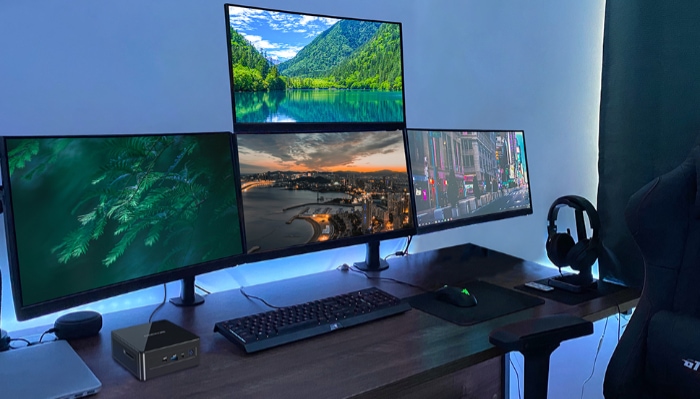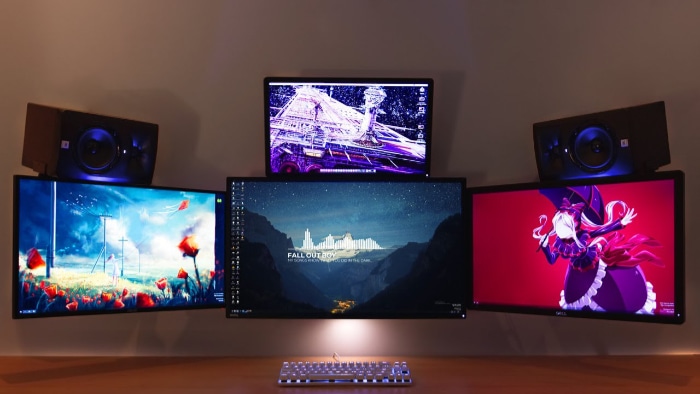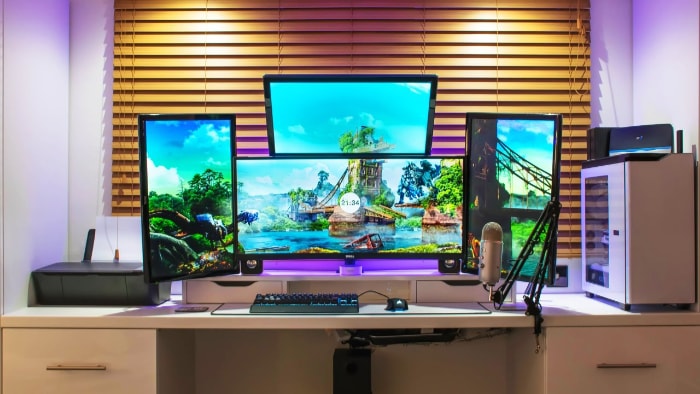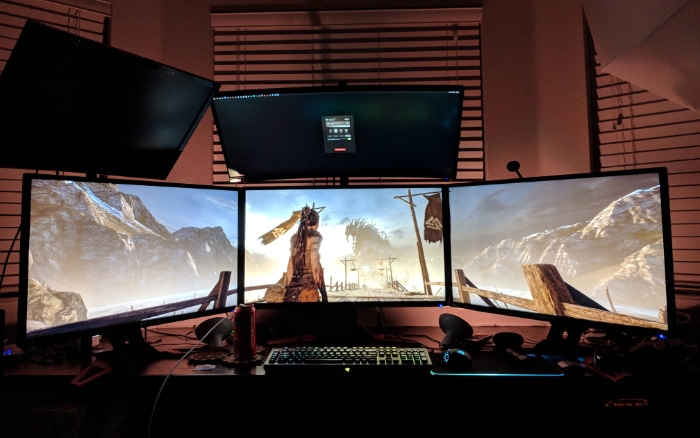How to Setup Quad Monitors: Maximizing Screen Real Estate

Quad monitor setups have swiftly transitioned from being a luxury to a near-necessity for many professionals and gaming enthusiasts. The allure of an expansive digital canvas, where one can spread out tasks, manage complex workflows with ease, and immerse in ultra-wide visuals, is hard to resist.
Such an arrangement not only promises an increase in productivity but also offers an unparalleled computing experience that single or dual screens simply cannot match. But how does one transition to this advanced setup? This guide is designed to demystify the process, laying out a step-by-step approach to construct a functional and aesthetically pleasing quad monitor workspace.
Whether you are a trader tracking markets, a creative professional juggling design tools, or a gamer seeking the ultimate in visual immersion, mastering the art of the quad monitor setup can redefine your screen interaction and enhance your digital life significantly.
Assessing Your Needs and Workspace
Crafting the ideal quad monitor setup starts with a thorough evaluation of what you hope to achieve and where you plan to set it up. Such setups are not a one-size-fits-all solution; they are highly personalized to cater to the user's specific needs.
This is why a careful analysis of your unique situation is crucial for crafting a space that not only fits your professional or gaming pursuits but also aligns with the physical and ergonomic constraints of your workspace.
Determining the Purpose of Your Monitors
The first step is to clarify what you aim to accomplish with your expanded visual workspace. Whether it's for stock trading, software development, digital design, or immersive gaming, each activity benefits from a quad monitor setup in different ways.
Understanding these needs will help inform decisions on the type of monitors you choose, such as prioritizing color accuracy for design or refresh rate for gaming.
Evaluating Your Physical Workspace
Your physical environment must be able to support a quad monitor layout. Measure your desk area, considering not just the length and depth but also the maximum weight it can handle, especially if you're looking at hefty gaming monitors.
Additionally, ensure there's enough room behind the desk for proper cable management and ventilation, as monitors can generate heat.
Considering the Ergonomic Implications
An ergonomic viewing experience is vital to prevent strain and fatigue. Monitors should be positioned to maintain a comfortable viewing distance, ideally allowing the screens to be at arm's length.
The height should be adjustable to keep the top of the monitor at or slightly below eye level. Moreover, the screens should allow for minimal head movement, with the most frequently used displays placed directly in front of you.
Essential Hardware Components

When venturing into the realm of a quad monitor setup, selecting the right hardware components is a crucial step. Each component, from the monitors themselves to the cables that connect them, plays a vital role in ensuring that the system operates seamlessly.
Monitors: Size, Resolution, and Panel Type
Choosing monitors for a quad setup is about balancing size and resolution for optimal clarity and space management. Larger monitors offer more screen real estate, but they require more desk space.
Conversely, higher resolutions offer sharper images and more screen space without physically larger monitors, with 4K being the premium choice for clarity. Panel type is also critical; IPS panels are renowned for better color reproduction and viewing angles, making them suitable for professional design work, whereas TN panels might be favored for their faster response times, benefiting gaming applications.
Graphics Cards: Requirements and Compatibility
A graphics card with multiple outputs is the linchpin of a quad monitor setup, capable of driving high-resolution displays without lag. Ensure that your card has at least four outputs and that it supports the resolutions of your chosen monitors.
High-end cards are recommended for intensive tasks such as 3D rendering or gaming across several screens, while mid-range cards might suffice for less demanding display tasks. Compatibility with your PC’s motherboard and power supply is also essential.
Mounts and Stands: Types and Space Considerations
Mounts and stands are not merely about holding your monitors in place; they are about optimizing viewing angles and reclaiming desk space. Freestanding mounts offer flexibility and ease of setup, while grommet or clamp mounts provide a more permanent and space-efficient solution.
Consider the arrangement—whether it’s 2×2, 1×4, or an arc—and ensure the chosen mount or stand can accommodate this configuration while providing stability and adjustability.
Cables and Adapters: Identifying What You Need
The final link in your setup is ensuring you have the right cables and adapters to connect your monitors to your graphics card. DisplayPort cables are commonly preferred for high refresh rates and resolutions, whereas HDMI is widely compatible but might not support the highest settings on all screens.
In some cases, adapters may be necessary to match the available outputs on your graphics card with the inputs on your monitors, such as DisplayPort to HDMI. Cable length should also be considered to maintain a clean setup, avoiding excess slack that can lead to disorganization.
Compatibility and Connectivity
Establishing a successful quad monitor setup involves ensuring that all components communicate effectively. Compatibility and connectivity form the foundation for functionality, allowing the monitors and computer to interact seamlessly.
This harmony between hardware and software determines the quality of the multi-monitor experience, from resolution and color consistency to the ease with which one can manage content across different screens.
Checking Computer Ports and Monitor Inputs
The first order of business is to verify the types of ports available on your computer and the input options on your monitors. Common ports include HDMI, DisplayPort, DVI, and VGA, with HDMI and DisplayPort being the most prevalent in modern setups.
It’s crucial that your computer’s graphics card has enough ports to match the number of monitors and that the ports are of the same type or compatible with the monitor inputs. If mismatches are present, you may need adapters to bridge the gap.
Understanding DisplayPort, HDMI, and Daisy-Chaining
DisplayPort and HDMI are the leading standards in transmitting video and audio. DisplayPort 1.2 and above allows for daisy-chaining, a method of connecting multiple monitors in a series using a single cable from the computer to the first monitor, and from there, connecting subsequent monitors.
HDMI is commonly used but does not support daisy-chaining. Each standard supports different resolutions, refresh rates, and audio capabilities, and choosing between them will depend on your monitors' resolutions and the desired frame rates.
Software Requirements for Managing Multiple Displays
The hardware setup is just one part of the equation; software plays a significant role in managing how content is displayed across multiple monitors. Most modern operating systems have built-in support for multi-monitor configurations, allowing for easy adjustment of resolution, orientation, and the arrangement of screens.
Additional software from the graphics card manufacturer, such as NVIDIA's nView or AMD's HydraVision, can offer more granular control, letting users fine-tune their setup for optimal performance and workflow efficiency. Ensuring that drivers and software are up to date is vital for the smooth functioning of a quad monitor arrangement.
The Setup Process

The transition to a quad monitor setup is an exciting upgrade to any workstation or gaming rig. While the idea of adding more screens may seem daunting, breaking down the process into manageable steps can ensure a smooth and successful installation.
The setup process covers everything from the physical placement of the monitors to the precise arrangement of cables, creating a streamlined and efficient workspace.
Physical Arrangement of Monitors
The physical layout of your monitors is a key factor in achieving the optimal viewing experience. Consider the shape and size of your desk when deciding how to arrange your monitors.
A common layout is the 2×2 square configuration, but depending on desk depth and width, a 1×4 horizontal setup or an L-shaped arrangement could be more appropriate. Ensure that the monitors are aligned at the same height and angle to provide a consistent viewing plane.
Installing Mounts or Stands
Once the arrangement is decided, the next step is to install the mounts or stands that will hold the monitors. If using freestanding mounts, this is generally straightforward.
However, grommet or clamp mounts require more attention to ensure they're secured properly to the desk. Ensure that the stands are capable of supporting the weight and size of your monitors and that they are tightened sufficiently to prevent any movement or sagging.
Connecting Monitors to the Graphics Card
With the mounts in place, it's time to connect the monitors to the graphics card. Begin by attaching the monitors to their respective cables, then connect these cables to the graphics card's outputs.
If your setup requires it, include any necessary adapters at this stage. It's important to be mindful of the input capabilities of each monitor to match them correctly with the graphics card's outputs, whether they are HDMI, DisplayPort, or another format.
Organizing Cables for a Clean Setup
A well-organized cable system is essential for both aesthetic appeal and functionality. Begin by grouping cables together using zip ties or cable management sleeves to reduce clutter.
Route the cables neatly along the back of the desk or through a cable management tray if available. This not only enhances the appearance of your setup but also prevents cable damage and makes it easier to troubleshoot any connection issues that may arise.
Configuration and Customization
Once the physical setup of a quad monitor system is complete, the next crucial step involves software configuration and display customization. These adjustments ensure that each monitor displays images accurately and that the entire system operates cohesively.
Fine-tuning display settings, calibrating each screen, and arranging your virtual workspace are all pivotal to leveraging the full potential of your setup.
Adjusting Display Settings in Your Operating System
The display settings in your operating system are where you can adjust the basic parameters of your monitors. Accessing the display settings panel, you can designate primary and secondary monitors and orient the screens to match their physical layout.
Resolution and scaling options can be tailored here as well, ensuring that text and images appear sharp and that interface elements are of a comfortable size. It is also the stage to set the correct refresh rate, which is crucial for ensuring smooth motion onscreen.
Calibrating Monitors for Uniformity
Calibration is the process of fine-tuning the monitor settings so that colors and brightness levels are consistent across all displays. Discrepancies between monitors can be jarring, so using calibration tools, either built into the operating system or provided by third-party software, can help adjust each screen to match as closely as possible.
For those requiring precision, such as photographers and video editors, hardware calibration tools can provide even greater accuracy.
Tailoring Your Workspace with Screen Layout
Customizing the screen layout is about more than just deciding where your windows go; it's about tailoring your virtual environment for optimal workflow and ergonomics. This might involve designating specific tasks to particular monitors, like having coding software on one, a web browser on another, and communication tools on a third.
For gamers, it might mean spreading the game interface across multiple screens for an immersive experience. The goal is to create a personalized workspace that enhances productivity and comfort.
Optimizing Your Quad Monitor Setup for Productivity

A quad monitor setup can significantly enhance productivity, offering ample digital real estate to keep numerous applications and workflows accessible simultaneously. To make the most of this expansive setup, it's vital to refine the way you interact with your array of screens.
Effective strategies, coupled with software solutions and customization, can transform your multi-monitor arrangement into a powerful hub for efficiency and multitasking.
Workflow Tips for Multiple Monitors
Effective management of a quad monitor environment begins with a strategic approach to your workflow. Assign specific tasks or applications to dedicated monitors.
For instance, you might reserve one screen for email and communication, another for web browsing and research, a third for active work such as writing or design, and the fourth for additional tools or reference materials. By doing so, you minimize the need to switch back and forth between applications, saving time and reducing cognitive load.
Utilizing Software Tools for Better Multitasking
Software tools can be invaluable in managing multiple monitors. Display management software allows for the customization of monitor layouts beyond what's available in standard operating system settings.
These tools can enable features like split screens within one monitor, the grouping of windows, or even spreading a single application across multiple monitors for an expanded view. Additionally, some programs offer the capability to move windows between monitors with keyboard shortcuts or to keep essential tools always on top, further streamlining the multitasking process.
Customizing Shortcuts and Screen Partitions
Shortcuts provide quick access to the functions and applications you use most frequently. Customizing these shortcuts to work with your multi-monitor setup can significantly improve your workflow efficiency.
By setting up hotkeys to move applications between monitors or to resize windows to fit half or a quarter of a screen, you create a more fluid interaction with your setup. Screen partitioning software can be particularly useful, allowing you to divide each monitor into designated areas for specific applications or documents.
This organization mimics having additional monitors by sectioning off areas for different tasks, which can be especially useful for complex projects requiring numerous resources visible simultaneously.
Creating profiles for different types of work can also enhance productivity. With the right software, you can switch between these profiles depending on whether you're editing video, coding, writing, or gaming.
This means you can have a customized setup for each activity, with window sizes and arrangements tailored to the task at hand, streamlining your workflow and minimizing the setup time required when switching contexts.
Conclusion
Embracing a quad monitor setup can revolutionize your computing experience, providing a broad canvas to enhance multitasking and productivity. From meticulously selecting the right hardware components to configuring and customizing software settings, each step plays a crucial role in creating an efficient and cohesive workstation.
The process involves not just a series of technical installations but also a deliberate design of one's digital workspace. By optimizing the configuration for your specific needs, you unlock the full potential of your monitors, allowing for a seamless flow of work across multiple screens.
Whether for professional endeavors, creative pursuits, or gaming, the power of a well-configured quad monitor setup is undeniable, offering a distinct advantage in the realm of digital efficiency.


